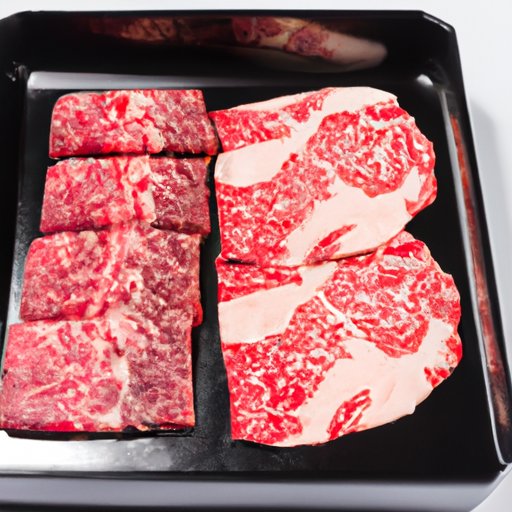
I. Introduction
Beef is a staple in many people’s diets, but it’s important to know how to identify bad beef to avoid getting sick. Eating bad beef can lead to food poisoning, which can cause severe symptoms, and sometimes even death. In this article, we’ll cover different ways to tell if beef is bad and provide tips to help you avoid consuming bad meat.
II. Examine the color and texture
The first way to tell if beef is bad is by examining its color and texture. Fresh beef should have a bright red color with white fat marbling throughout it. Bad beef, on the other hand, will have a grayish color due to oxidation of the fat. Additionally, if the beef feels slimy or sticky to the touch, it’s probably gone bad.
It’s important to visually inspect your beef before cooking or consuming it. If you notice any of these signs, discard the beef immediately.
III. Smell the beef
Another way to tell if beef is bad is by smelling it. Bad beef often has a sour or unusual odor that’s indicative of spoilage. If the beef smells like ammonia or sulfur, it’s a sign that it’s spoiled.
Trust your nose and discard any meat that smells off. It’s better to be safe than sorry.
IV. Check the packaging
Checking the packaging is critical when buying beef. Always check the expiration date and ensure the packaging is intact and free from damage. Your beef should be properly vacuum-sealed or wrapped in plastic packaging to keep it fresh.
Never purchase beef that is past its expiration date or has damaged packaging. It’s also important to store the beef carefully on your way home from the grocery store to avoid any damage to the packaging.
V. Feel the beef
Fresh beef should feel firm to the touch, with a little bit of bounce back when you press it. If the beef feels mushy or soft, it’s likely spoiled. This can be a sign of bacterial growth or that it’s been stored for an extended period.
Feeling the beef can help you determine its freshness, but it’s still important to check its other characteristics before deciding to cook or consume it.
VI. Look for discoloration
Another sign that beef is bad is discoloration. Bad beef may have spots of discoloration or darkened areas. These can be caused by oxidized fat, bacterial growth, or exposure to air.
Discard any beef that has discoloration or dark spots. It’s better to be safe than sorry, and consuming it can lead to food poisoning.
VII. Cook it properly
Cooking beef properly can kill harmful bacteria and make it safe to eat. The internal temperature of beef should reach 145°F (63°C) for steaks and roasts, and 160°F (71°C) for ground beef.
Use a meat thermometer to check the internal temperature, and ensure that the beef is cooked evenly. Avoid rare or undercooked beef to prevent the risk of food poisoning.
VIII. Store it properly
Storing beef properly is crucial to ensure its freshness. Always refrigerate your beef promptly after purchasing it, and ensure it’s stored at 40°F (4°C) or below. Use your beef within two to three days.
If you’re not going to use the beef within three days, freeze the meat. The beef can be stored in the freezer for up to six months. Ensure that you wrap it tightly and use a freezer-safe container to prevent freezer burn and contamination.
IX. Conclusion
Knowing how to tell if beef is bad is crucial for your health. Always check the color and texture, smell the beef, check the packaging, feel the beef, and look for any discoloration. Cook your beef properly and store it correctly to ensure its freshness.
By following these tips, you’ll be able to enjoy beef without worrying about getting sick. Stay safe and healthy, and always remember to trust your instincts.




